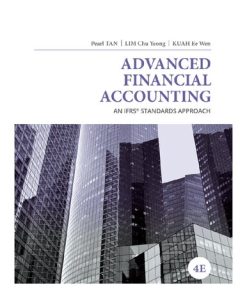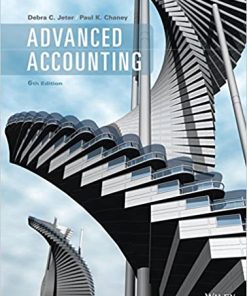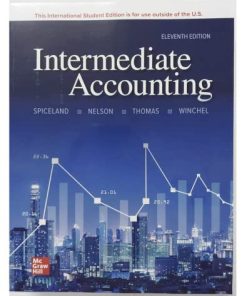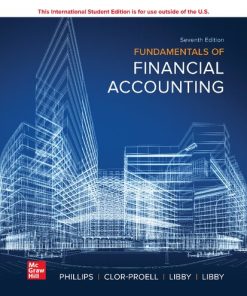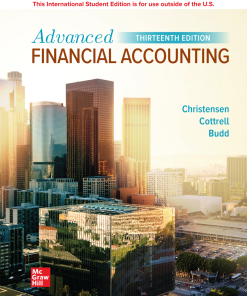ISE Advanced Financial Accounting 13th Edition by Theodore Christensen, David Cottrell, Cassy Budd 1264071841 9781264071845
$50.00 Original price was: $50.00.$25.00Current price is: $25.00.
ISE Advanced Financial Accounting 13th Edition by Theodore E. Christensen, David Cottrell, Cassy Budd – Ebook PDF Instant Download/DeliveryISBN: 1264071841, 9781264071845
Full download ISE Advanced Financial Accounting 13th Edition after payment.

Product details:
ISBN-10 : 1264071841
ISBN-13 : 9781264071845
Author : Theodore E. Christensen, David Cottrell, Cassy Budd
The Thirteenth Edition of Advanced Financial Accounting is an up-to-date, comprehensive, and highly illustrated presentation of the accounting and reporting principles and procedures used in a variety of business entities. Every day, the business press carries stories about merger and acquisition mania, the complexities of modern business entities, new organizational structures for conducting business, accounting scandals related to complex business transactions, the foreign activities of multinational firms, the operations of governmental and not-for-profit entities, and bankruptcies of major firms. Accountants must understand and know how to deal with the accounting and reporting ramifications of these issues.
ISE Advanced Financial Accounting 13th Table of contents
Chapter 1 Intercorporate Acquisitions and Investments in other Entities
T-Mobile’s Merger with Sprint
An Introduction to Complex Business Structures
Enterprise Expansion
Business Objectives
Frequency of Business Combinations
Ethical Considerations
Business Expansion and Forms of Organizational Structure
Internal Expansion: Creating a Business Entity
External Expansion: Business Combinations
Organizational Structure and Financial Reporting
The Development of Accounting for Business Combinations
Accounting for Internal Expansion: Creating Business Entities
Accounting for External Expansion: Business Combinations
Legal Forms of Business Combinations
Methods of Effecting Business Combinations
Valuation of Business Entities
Acquisition Accounting
Fair Value Measurements
Applying the Acquisition Method
Goodwill
Combination Effected through the Acquisition of Net Assets
Combination Effected through Acquisition of Stock
Financial Reporting Subsequent to a Business Combination
Additional Considerations in Accounting for Business Combinations
Uncertainty in Business Combinations
In-Process Research and Development
Noncontrolling Equity Held Prior to Combination
Summary of Key Concepts
Key Terms
Questions
Cases
Exercises
Problems
Chapter 2 Reporting Intercorporate Investments and Consolidation of Wholly Owned Subsidiaries with No Differential
Berkshire Hathaway’s Many Investments
Accounting for Investments in Common Stock
Securities Carried at Fair Value
Accounting Procedures for Securities Carried at Fair Value
Changes in the Number of Shares Held
The Equity Method
Use of the Equity Method
Investor’s Equity in the Investee
Recognition of Income
Recognition of Dividends
Carrying Amount of the Investment and Investment Income under the Equity Method
Changing to the Equity Method at an Interim Date
Acquisition at Interim Date
Changes in the Number of Shares Held
Investments Carried at Fair Value and Investments Accounted for Using the Equity Method
Overview of the Consolidation Process
Consolidation Procedures for Wholly Owned Subsidiaries That Are Created or Purchased at Book Value
Consolidation Worksheets
Worksheet Format
Nature of Consolidation Entries
Consolidated Balance Sheet with Wholly Owned Subsidiary
100 Percent Ownership Acquired at Book Value
Consolidation Subsequent to Acquisition
Consolidated Net Income
Consolidated Retained Earnings
Consolidated Financial Statements—100 Percent Ownership, Created or Acquired at Book Value
Initial Year of Ownership
Second and Subsequent Years of Ownership
Consolidated Net Income and Retained Earnings
Summary of Key Concepts
Key Terms
APPENDIX 2A Additional Considerations Relating to the Equity Method
APPENDIX 2B Consolidation When Parent Companies Choose to Carry at Cost Investments That Are to Be Consolidated
Questions
Cases
Exercises
Problems
Chapter 3 The Reporting Entity and the Consolidation of Less-Than-Wholly-Owned Subsidiaries with No Differential
The Coca-Cola Company
The Usefulness of Consolidated Financial Statements
Limitations of Consolidated Financial Statements
Subsidiary Financial Statements
Consolidated Financial Statements: Concepts and Standards
Traditional View of Control
Indirect Control
Ability to Exercise Control
Differences in Fiscal Periods
Changing Concept of the Reporting Entity
Noncontrolling Interest
Computation and Presentation of Noncontrolling Interest
The Effect of a Noncontrolling Interest
Consolidated Net Income
Consolidated Retained Earnings
Worksheet Format
Consolidated Balance Sheet with a Less-Than-Wholly-Owned Subsidiary
80 Percent Ownership Acquired at Book Value
Consolidation Subsequent to Acquisition—80 Percent Ownership Acquired at Book Value
Initial Year of Ownership
Second and Subsequent Years of Ownership
Combined Financial Statements
Special-Purpose and Variable Interest Entities
Variable Interest Entities
Summary of Key Concepts
Key Terms
APPENDIX 3A Consolidation of Variable Interest Entities
Questions
Cases
Exercises
Problems
Chapter 4 Consolidation of Wholly Owned Subsidiaries Acquired at More Than Book Value
How Much Work Does It Really Take to Consolidate? Ask the People Who Do It at Disney
Dealing with the Differential
The Difference between Acquisition Price and Underlying Book Value
Consolidation Procedures for Wholly Owned Subsidiaries Acquired at More Than Book Value
Treatment of a Positive Differential
Illustration of Treatment of a Complex Differential
100 Percent Ownership Acquired at Less Than Fair Value of Net Assets
Illustration of Treatment of Bargain Purchase
Consolidated Financial Statements—100 Percent Ownership Acquired at More Than Book Value
Initial Year of Ownership
Second Year of Ownership
Intercompany Receivables and Payables
Push-Down Accounting
Summary of Key Concepts
Key Terms
APPENDIX 4A Push-Down Accounting Illustrated
Questions
Cases
Exercises
Problems
Chapter 5 Consolidation of Less-Than-Wholly-Owned Subsidiaries Acquired at More Than Book Value
Walmart Acquires a Controlling Interest in Massmart
A Noncontrolling Interest in Conjunction with a Differential
Consolidated Balance Sheet with Majority-Owned Subsidiary
Consolidated Financial Statements with a Majority-Owned Subsidiary
Initial Year of Ownership
Second Year of Ownership
Discontinuance of Consolidation
Treatment of Other Comprehensive Income
Modification of the Consolidation Worksheet
Adjusting Entry Recorded by Subsidiary
Adjusting Entry Recorded by Parent Company
Consolidation Worksheet—Second Year Following Combination
Consolidation Procedures
Consolidation Worksheet—Comprehensive Income in Subsequent Years
Summary of Key Concepts
Key Terms
APPENDIX 5A Additional Consolidation Details
Questions
Cases
Exercises
Problems
Chapter 6 Intercompany Inventory Transactions
Inventory Transfers at Samsung Electronics
Overview of the Consolidated Entity and Intercompany Transactions
Elimination of Intercompany Transfers
Elimination of Unrealized Profits and Losses
Inventory Transactions
Worksheet Consolidation Entries
Transfers at Cost
Transfers at a Profit or Loss
Calculating Unrealized Profit or Loss
Deferring Unrealized Profit or Loss on the Parent’s Books
Deferring Unrealized Profit or Loss in the Consolidation
Why Adjust the Parent’s Books and Make Worksheet Entries?
Downstream Inventory Sale
Year 1
Year 2
Upstream Inventory Sale
Additional Considerations
Sale from One Subsidiary to Another
Sales and Purchases before Affiliation
Summary of Key Concepts
Key Terms
APPENDIX 6A Intercompany Inventory Transactions—Modified Equity Method and Cost Method
Questions
Cases
Exercises
Problems
Chapter 7 Intercompany Transfers of Services and Noncurrent Assets
Micron’s Intercompany Fixed Asset Sale
Intercompany Transfers of Services
Intercompany Long-Term Asset Transfers
Intercompany Land Transfers
Overview of the Profit Consolidation Process
Assignment of Unrealized Profit Consolidation
Downstream Land Sale—Comprehensive Three-Year Example
Year 1—Downstream Land Sale
Year 2—Subsidiary Holds Land
Year 3—Land Sold to Nonafilliated Party
Upstream Sale of Land (Year of Sale)
Intercompany Transfers of Depreciable Assets
Downstream Sale
Change in Estimated Life of Asset upon Transfer
Upstream Sale
Asset Transfers before Year-End
Intercompany Transfers of Amortizable Assets
Summary of Key Concepts
Key Terms
APPENDIX 7A Intercompany Noncurrent Asset Transactions—Modified Equity Method and Cost Method
Questions
Cases
Exercises
Problems
Chapter 8 Intercompany Indebtedness
Caesars Entertainment Corporation’s Debt Transfers
Consolidation Overview
Bond Sale Directly to an Affiliate
Transfer at Par Value
Transfer at a Discount or Premium
Bonds of Affiliate Purchased from a Nonaffiliate
Purchase at Book Value
Purchase at an Amount Less Than Book Value
Purchase at an Amount Higher Than Book Value
Summary of Key Concepts
Key Terms
APPENDIX 8A Intercompany Indebtedness—Fully Adjusted Equity Method Using Straight-Line Interest Amortization
APPENDIX 8B Intercompany Indebtedness—Modified Equity Method and Cost Method
Questions
Cases
Exercises
Problems
Chapter 9 Consolidation Ownership Issues
Berkshire Hathaway’s Varied Investments
Subsidiary Preferred Stock Outstanding
Consolidation with Subsidiary Preferred Stock Outstanding
Subsidiary Preferred Stock Held by Parent
Subsidiary Preferred Stock with Special Provisions
Illustration of Subsidiary Preferred Stock with Special Features
Changes in Parent Company Ownership
Parent’s Purchase of Additional Shares from Nonaffiliate
Parent’s Sale of Subsidiary Shares to Nonaffiliate
Subsidiary’s Sale of Additional Shares to Nonaffiliate
Subsidiary’s Sale of Additional Shares to Parent
Subsidiary’s Purchase of Shares from Nonaffiliate
Subsidiary’s Purchase of Shares from Parent
Complex Ownership Structures
Multilevel Ownership and Control
Reciprocal or Mutual Ownership
Subsidiary Stock Dividends
Illustration of Subsidiary Stock Dividends
Impact on Subsequent Periods
Summary of Key Concepts
Key Terms
Questions
Cases
Exercises
Problems
Chapter 10 Additional Consolidation Reporting Issues
Advanced Consolidation Issues at Alphabet
Consolidated Statement of Cash Flows
Preparation of a Consolidated Cash Flow Statement
Consolidated Cash Flow Statement Illustrated
Consolidated Cash Flow Statement—Direct Method
Consolidation Following an Interim Acquisition
Parent Company Entries
Consolidation Worksheet
Consolidation Income Tax Issues
Allocating the Basis of Assets Acquired in a Business Combination
Tax Allocation Procedures When Separate Tax Returns Are Filed
Tax Effects of Unrealized Intercompany Profit Eliminations
Consolidated Earnings per Share
Computation of Diluted Consolidated Earnings per Share
Computation of Consolidated Earnings per Share Illustrated
Summary of Key Concepts
Key Terms
Questions
Cases
Exercises
Problems
Chapter 11 Multinational Accounting: Foreign Currency Transactions and Financial Instruments
Microsoft’s Multinational Business
Doing Business in a Global Market
The Accounting Issues
Foreign Currency Exchange Rates
The Determination of Exchange Rates
Direct versus Indirect Exchange Rates
Changes in Exchange Rates
Spot Rates versus Current Rates
Forward Exchange Rates
Foreign Currency Transactions
Foreign Currency Import and Export Transactions
Managing International Currency Risk with Foreign Currency Forward Exchange Financial Instruments
Derivatives Designated as Hedges
Forward Exchange Contracts
Case 1: Managing an Exposed Foreign Currency Net Asset or Liability Position: Not a Designated Hedging Instrument
Case 2: Hedging an Unrecognized Foreign Currency Firm Commitment: A Foreign Currency Fair Value Hedge
Case 3: Hedging a Forecasted Foreign Currency Transaction: A Foreign Currency Cash Flow Hedge
Case 4: Speculation in Foreign Currency Markets
Foreign Exchange Matrix
Additional Considerations
A Note on Measuring Hedge Effectiveness
Interperiod Tax Allocation for Foreign Currency Gains (Losses)
Hedges of a Net Investment in a Foreign Entity
Summary of Key Concepts
Key Terms
APPENDIX 11A Illustration of Valuing Forward Exchange Contracts with Recognition for the Time Value of Money
APPENDIX 11B Use of Other Financial Instruments by Multinational Companies
Questions
Cases
Exercises
Problems
Chapter 12 Multinational Accounting: Issues in Financial Reporting and Translation of Foreign Entity Statements
MCDonald’s—The World’s Fast Food Favorite
Convergence of Accounting Principles
Accounting for Differences in Currencies and Exchange Rates
Currency Definitions
Determination of the Functional Currency
Functional Currency Designation in Highly Inflationary Economies
Translation versus Remeasurement of Foreign Financial Statements
Translation of Functional Currency Statements into the Reporting Currency of the U.S. Company
Financial Statement Presentation of Translation Adjustment
Illustration of Translation and Consolidation of a Foreign Subsidiary
Noncontrolling Interest of a Foreign Subsidiary
Remeasurement of the Books of Record into the Functional Currency
Statement Presentation of Remeasurement Gain or Loss
Illustration of Remeasurement of a Foreign Subsidiary
Proof of Remeasurement Exchange Gain
Remeasurement Case: Subsequent Consolidation Worksheet
Summary of Translation versus Remeasurement
Additional Considerations in Accounting for Foreign Operations and Entities
Foreign Investments and Unconsolidated Subsidiaries
Liquidation of a Foreign Investment
Hedge of a Net Investment in a Foreign Subsidiary
Disclosure Requirements
Statement of Cash Flows
Lower-of-Cost-or-Market Inventory Valuation under Remeasurement
Intercompany Transactions
Income Taxes
Translation When a Third Currency Is the Functional Currency
Summary of Key Concepts
Key Terms
Questions
Cases
Exercises
Problems
Chapter 13 Segment and Interim Reporting
Segment Reporting at Walmart
Reporting for Segments
Segment Reporting Accounting Issues
International Financial Reporting Standards for Operating Segments
Information about Operating Segments
Defining Reportable Segments
Comprehensive Disclosure Test
Reporting Segment Information
Enterprisewide Disclosures
Information about Products and Services
Information about Geographic Areas
Information about Major Customers
Interim Financial Reporting
The Format of the Quarterly Financial Report
Accounting Issues
Accounting Pronouncements on Interim Reporting
International Financial Reporting Standards for Interim Reporting
Reporting Standards for Interim Income Statements
Revenue
Cost of Goods Sold and Inventory
All Other Costs and Expenses
Accounting for Income Taxes in Interim Periods
Disposal of a Component of the Entity or Unusual, Infrequently Occurring, and Contingent Items
Accounting Changes in Interim Periods
Change in an Accounting Principle (Retrospective Application)
Change in an Accounting Estimate (Current and Prospective Application)
Changes in Depreciation, Amortization, or Depletion
Change in a Reporting Entity (Retrospective Application)
International Financial Reporting Standards for Accounting Changes
Summary of Key Concepts
Key Terms
Questions
Cases
Exercises
Problems
Chapter 14 SEC Reporting
The Genesis of Securities Regulation
International Harmonization of Accounting Standards for Public Offerings
Securities and Exchange Commission
Organizational Structure of the Commission
Laws Administered by the SEC
The Regulatory Structure
Issuing Securities: The Registration Process
The Registration Statement
SEC Review and Public Offering
Accountants’ Legal Liability in the Registration Process
Periodic Reporting Requirements
Accountants’ Legal Liability in Periodic Reporting
Electronic Data Gathering, Analysis, and Retrieval (EDGAR) System
Foreign Corrupt Practices Act of 1977
Sarbanes-Oxley Act of 2002
Title I: Public Company Accounting Oversight Board
Title II: Auditor Independence
Title III: Corporate Responsibility
Title IV: Enhanced Financial Disclosures
Title V: Analyst Conflicts of Interest
Title VI: Commission Resources and Authority
Title VII: Studies and Reports
Title VIII: Corporate and Criminal Fraud Accountability
Title IX: White-Collar Crime Penalty Enhancements
Title X: Sense of Congress Regarding Corporate Tax Returns
Title XI: Corporate Fraud and Accountability
Dodd-Frank Wall Street Reform and Consumer Protection Act
Jumpstart Our Business Startups (JOBS) Act
Disclosure Requirements
Management Discussion and Analysis
Pro Forma Disclosures
Summary of Key Concepts
Key Terms
Questions
Cases
Exercises
Chapter 15 Partnerships: Formation, Operation, and Changes in Membership
The Evolution of PricewaterhouseCoopers (PwC)
The Nature of the Partnership Entity
Legal Regulation of Partnerships
Definition of a Partnership
Formation of a Partnership
Other Major Characteristics of Partnerships
Accounting and Financial Reporting Requirements for Partnerships
International Financial Reporting Standards for Small and Medium-Size Entities and Joint Ventures
Accounting for the Formation of a Partnership
Illustration of Accounting for Partnership Formation
Accounting for the Operations of a Partnership
Partners’ Accounts
Allocating Profit or Loss to Partners
Illustrations of Profit Allocation
Multiple Profit Allocation Bases
Special Profit Allocation Methods
Partnership Financial Statements
Changes in Membership
General Concepts to Account for a Change in Membership in the Partnership
New Partner Purchases a Partnership Interest Directly from an Existing Partner
New Partner Invests in the Partnership
Determining a New Partner’s Investment Cost
Disassociation of a Partner from the Partnership
Summary of Key Concepts
Key Terms
APPENDIX 15A Tax Aspects of a Partnership
APPENDIX 15B Joint Ventures
Questions
Cases
Exercises
Problems
Chapter 16 Partnerships: Liquidation
The Demise of Laventhol & Horwath
Overview of Partnership Liquidations
Disassociation, Dissolution, Winding-Up, and Liquidation of a Partnership
Lump-Sum Liquidations
Realization of Assets
Liquidation Expenses
Illustration of a Lump-Sum Liquidation
Installment Liquidations
Illustration of Installment Liquidation Using Schedules of Safe Payments
Cash Distribution Plan
Additional Considerations
Incorporation of a Partnership
Summary of Key Concepts
Key Terms
APPENDIX 16A Partners’ Personal Financial Statements
Questions
Cases
Exercises
Problems
Chapter 17 Governmental Entities: Introduction and General Fund Accounting
Accounting for the Bustling City of San Diego
Differences between Governmental and Private Sector Accounting
History of Governmental Accounting
Major Concepts of Governmental Accounting
Elements of Financial Statements
Expendability of Resources versus Capital Maintenance Objectives
Definitions and Types of Funds
Financial Reporting of Governmental Entities
Fund-Based Financial Statements: Governmental Funds
Measurement Focus and Basis of Accounting (MFBA)
Basis of Accounting—Governmental Funds
Basis of Accounting—Proprietary Funds
Basis of Accounting—Fiduciary Funds
Budgetary Aspects of Governmental Operations
Recording the Operating Budget
Accounting for Expenditures
The Expenditure Process
Classification of Expenditure Transactions and Accounts
Outstanding Encumbrances at the End of the Fiscal Period
Expenditures for Inventory
Accounting for Fixed Assets
Long-Term Debt and Capital Leases
Investments
Interfund Activities
Interfund Loans
Interfund Services Provided and Used
Interfund Transfers
Interfund Reimbursements
Overview of Accounting and Financial Reporting for the General Fund
Comprehensive Illustration of Accounting for the General Fund
Adoption of the Budget
Property Tax Levy and Collection
Other Revenue
Expenditures
Acquisition of Capital Asset
Interfund Activities
Adjusting Entries
Closing Entries
General Fund Financial Statement Information
Summary of Key Concepts
Key Terms
Questions
Cases
Exercises
Problems
Chapter 18 Governmental Entities: Special Funds and Governmentwide Financial Statements
Governmental Accounting in Maryland
Summary of Governmental Fund Types
Governmental Funds Worksheets
Special Revenue Funds
Capital Projects Funds
Illustration of Transactions
Financial Statement Information for the Capital Projects Fund
Debt Service Funds
Illustration of Transactions
Financial Statement Information for the Debt Service Fund
Permanent Funds
Illustration of Transactions
Governmental Funds Financial Statements
Enterprise Funds
Illustration of Transactions
Financial Statements for the Proprietary Funds
Internal Service Funds
Illustration of Transactions
Financial Statements for Internal Service Funds
Trust Funds
Illustration of Private-Purpose Trust Fund
Agency Funds
Illustration of Transactions in an Agency Fund
The Government Reporting Model
Four Major Issues
Government Financial Reports
Governmentwide Financial Statements
Reconciliation Schedules
Budgetary Comparison Schedule
Management’s Discussion and Analysis
Notes to the Governmentwide Financial Statements
Other Financial Report Items
Interim Reporting
Auditing Governmental Entities
Additional Considerations
Special-Purpose Governmental Entities
Summary of Key Concepts
Key Terms
APPENDIX 18A Other Governmental Entities—Public School Systems and the Federal Government
Questions
Cases
Exercises
Problems
Chapter 19 Not-for-Profit Entities
United Way Worldwide
Financial Reporting for Private, Not-for-Profit Entities
Additional Standards for Not-for-Profit Entities
Colleges and Universities
Special Conventions of Revenue and Expenditure Recognition
Board-Designated Funds
Public Colleges and Universities
Private Colleges and Universities
Health Care Providers
Hospital Accounting
Financial Statements for a Not-for-Profit Hospital
Comprehensive Illustration of Hospital Accounting and Financial Reporting
Summary of Hospital Accounting and Financial Reporting
Voluntary Health and Welfare Organizations
Accounting for a VHWO
Financial Statements for a VHWO
Summary of Accounting and Financial Reporting for VHWOs
Other Not-for-Profit Entities
Accounting for an ONPO
Financial Statements of an ONPO
Summary of Accounting and Financial Reporting for an ONPO
Summary of Key Concepts
Key Terms
Questions
Cases
Exercises
Problems
Chapter 20 Corporations in Financial Difficulty
GM in Financial Distress
Courses of Action
Nonjudicial Actions
Judicial Actions
Chapter 11 Reorganizations
Fresh Start Accounting
Plan of Reorganization
Illustration of a Reorganization
Chapter 7 Liquidations
Classes of Creditors
Secured Creditors
Creditors with Priority
General Unsecured Creditors
Statement of Affairs
Additional Considerations
Trustee Accounting and Reporting
People also search for ISE Advanced Financial Accounting 13th:
what is advanced financial accounting
how to study advanced accounting
is advanced financial accounting hard
advanced accounting answer key
advanced accounting final exam
Tags: ISE Advanced, Financial Accounting, Theodore Christensen, David Cottrell, Cassy Budd
You may also like…
Education Studies & Teaching
Business & Economics
Business & Economics - Accounting
Psychology - Developmental Psychology
ISE Adolescence 13th Edition by Laurence Steinberg 1265740481 9781265740481
Business & Economics - Accounting
Advanced Financial Accounting 12th Edition Theodore E. Christensen
Uncategorized
Business & Economics - Accounting
Business & Economics - Professional Finance
Fundamentals of Financial Accounting 7th Edition Fred Phillips
Business & Economics - Accounting
Advanced Financial Accounting 13th Edition Theodore E. Christensen




